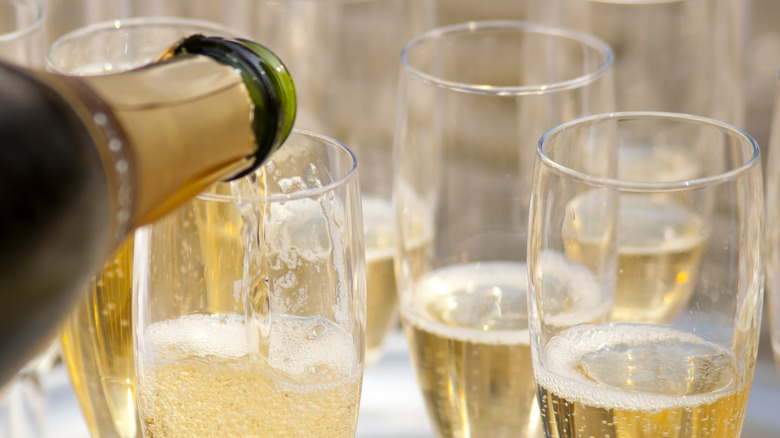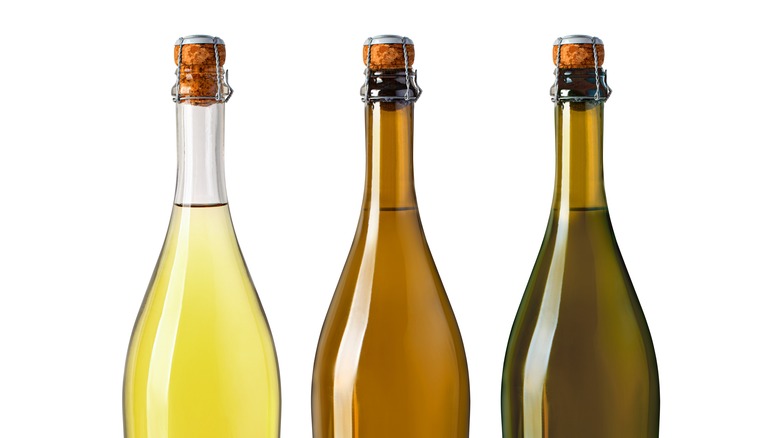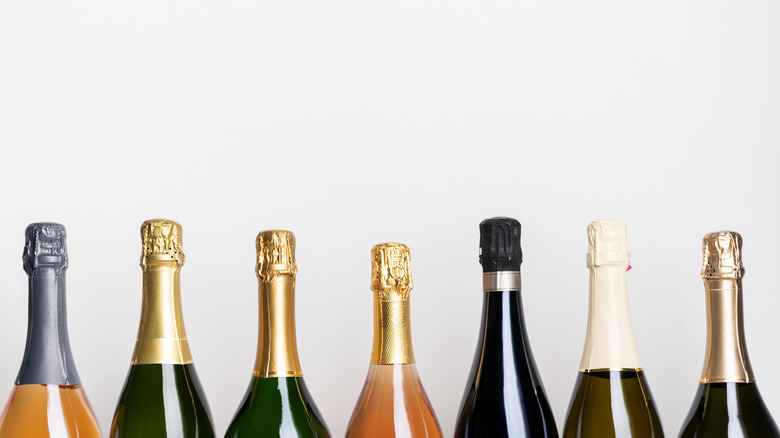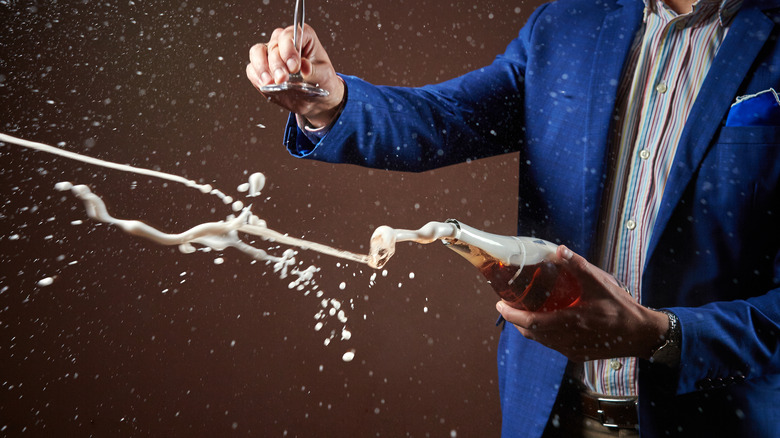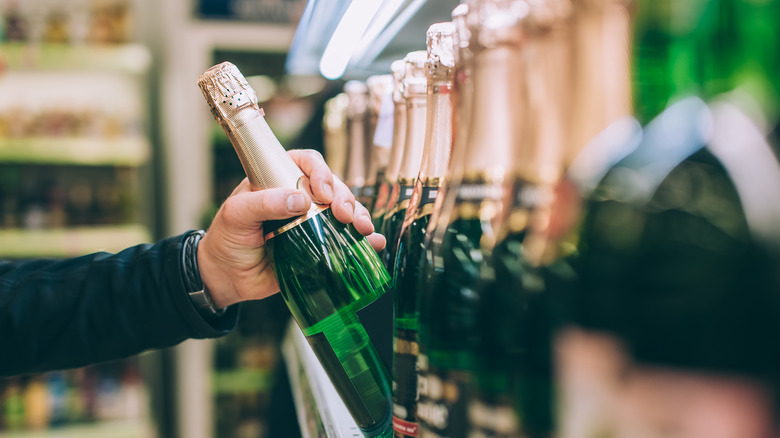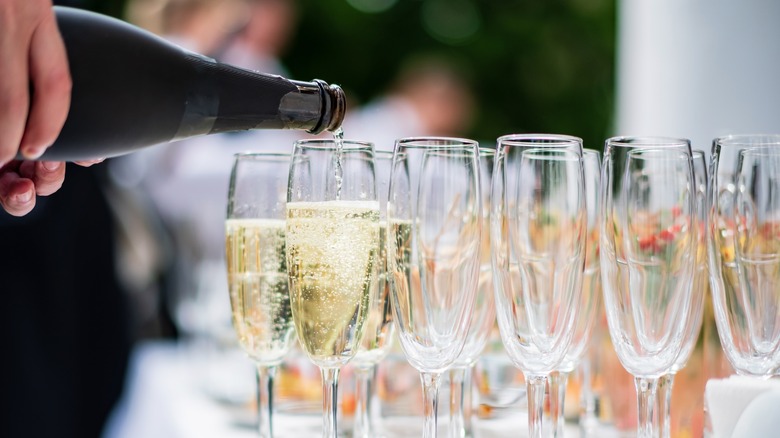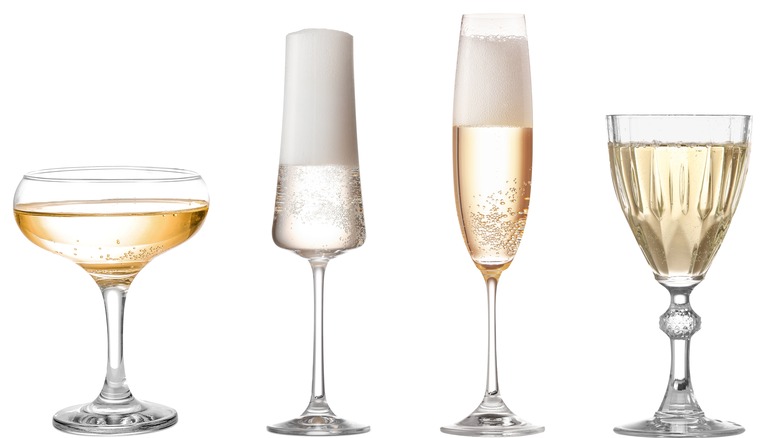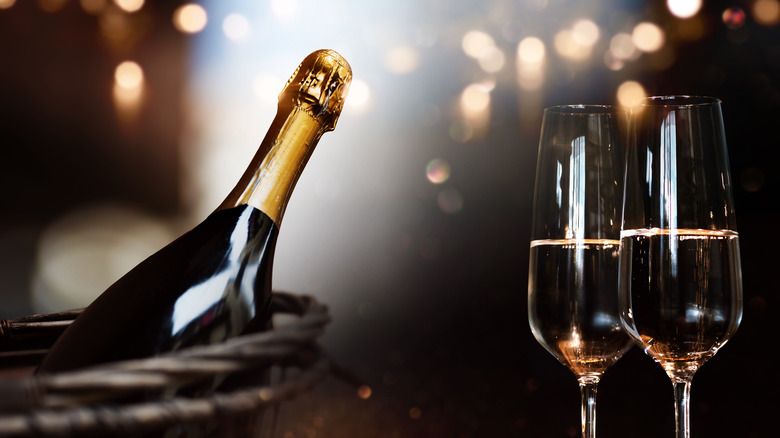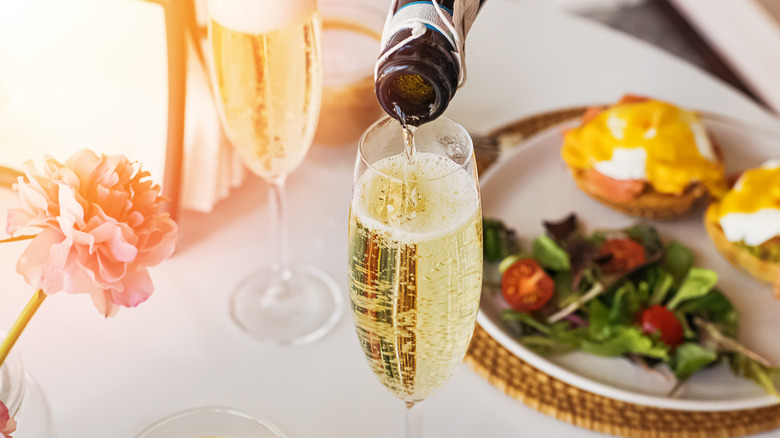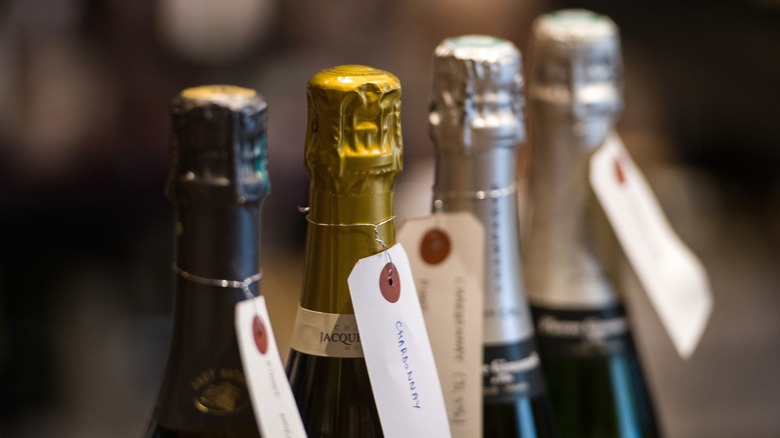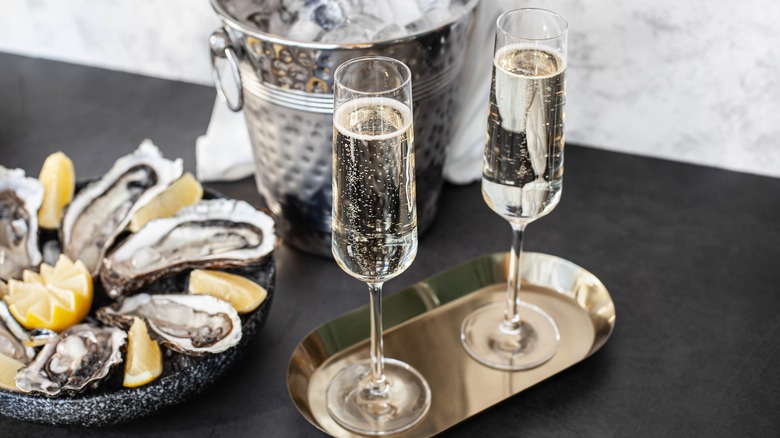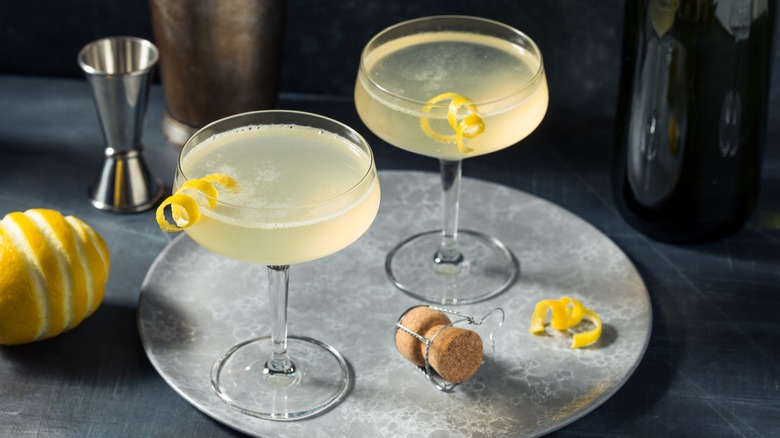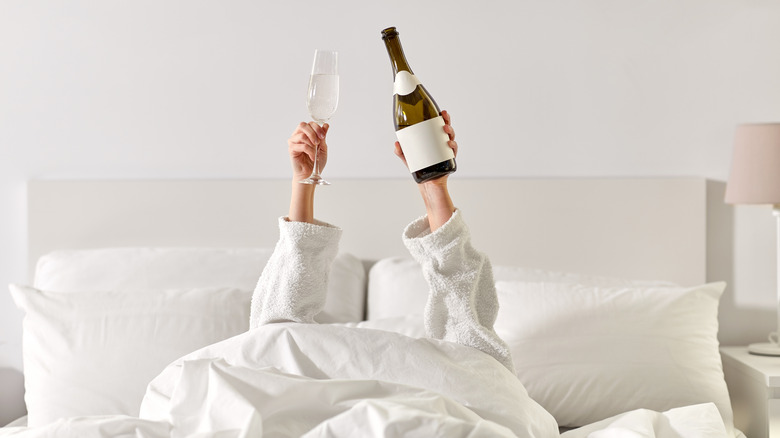12 Mistakes Everyone Makes When Drinking Sparkling Wine
We may receive a commission on purchases made from links.
Sparkling wines are unique and can't compare to other wine styles. They can be made with various grapes and using different methods, but all come packed with tiny bubbles that provide textural components and bring all those aromas and flavors to the front. When paired with balanced acidity and pleasant aromas, effervescence builds wines that make ideal food partners and fantastic aperitifs.
Sparkling wines are technically demanding to make. They can be produced with the traditional method in which sugar and yeast are fermented in the bottle, or with the Charmat method in which the second fermentation takes place in large vats. These techniques produce strikingly different wines, and among the same category, there is a vast number of sub-styles, all depending on the chosen grapes, terroir, and age. Luckily, this ensures that everyone can find their ideal bubbly (via We Drink Bubbles).
While they often carry the unworthy label of being overly complicated, this could not be further from the truth. To become a pro at drinking sparkling wine, read the following round-up of the most common mistakes wine enthusiasts make. It will teach you how to avoid errors in serving and savoring sparkling wines, and it will inspire you to forget the old-fashioned pairings and find the new perfect match for your favorite bubbly.
Not exploring various sparkling styles
If you are unfamiliar with sparkling wines, you may mistakenly believe that there is one uniform category, but the reality is much different. Sparkling wines can be made with several techniques and different grape varieties, resulting in many diverse styles that vary in flavor, level of effervescence, aromas, sweetness, and character. Wine Folly makes a basic distinction between zesty and creamy sparkling styles. The former category includes sparkling styles made with a reductive method, which aims to keep all the floral and fruity notes, generally creating dry wines that can again differ in aromatic profile and sweetness. The wines falling in the creamy category are usually made with the oxidative technique and are often improved by aging. These examples, which include vintage Champagne and Cava Reserva, will usually have a creamier texture and distinctive nutty, toasty, and brioche-like notes.
One of the main distinctions regarding sparkling wine is the level of sweetness (dosage), which will usually be written on the label. The terminology is sometimes regional and can be slightly confusing, but it simply refers to the level of residual sugar that is left in the wine. Dry wines will usually be labeled as brut (or herb for German Sekt), and the scale then leads from dry (also labeled as sec, secco, or trocken) to sweet. Demi-sec and doux are the ones with the highest residual sweetness; if you're looking for sparkling wine that is on the sweeter side, opt for those (via Vine Pair).
Only sticking to Champagne
Champagne is one of the best wines in the world and the most famous representative of the sparkling wine group, but it's only a tiny fraction of the world of bubblies. This legendary wine is produced with the traditional method and seven grape varieties, though Chardonnay and Pinot Noir are dominant. Along with strict age requirements, advanced wine-making techniques, and exceptional terroir, Champagne's quality is indisputable, but it would be a shame to only stick to one example when there is a plethora of available options, some even being able to parallel with the great Champagne.
Among the wines made with the traditional method, Crémant is the closest thing to Champagne. The term is applied to several French sparkling wine regions that make exceptional sparkling wines, which are generally more affordable than Champagne. Italian Franciacorta from Lombardy is another excellent option, while Spanish Cava makes a great value alternative that can be sipped on any occasion.
Charmat or tank method wines will lean to the fruity and floral profile with fewer toasty notes. Though they are less revered, the wines are often of exceptional quality and tend to be less pricey. Prosecco is one of the most popular representatives that has won over the world with its light body and unpretentious character, while Asti Spumante makes a great alternative for a more aromatic Italian bubbly (via Wine).
Always popping the bottle
Sparkling wines have long had the image of a celebratory wine – the one opened at celebrations commemorating people, occasions, or any accomplishment – and the pop of the cork signaled the beginning of the party. However, sending the cork flying isn't the best way to open a bubbly. As the Union of Champagne Houses explains, the best way to open Champagne – though the idea applies to all sparkling wines – is to do it discreetly, without the popping sound, as the loud bang is now considered inappropriate. Along with the sheer danger of the flying cork, the pressure in the bottle will drop when opened suddenly, which can ruin the effervescence.
La Patiala shares instructions on how to correctly open sparkling wine: Firstly, ensure that the wine is sufficiently chilled, as there is a higher chance of the cork popping if the wine is warm. Ideally, the wine will be around 45 degrees Fahrenheit. Next, take off the foil to get free access to the wire cage. To prevent disaster, hold the cork with one hand and release the cage to get to the cork. Instead of twisting the cork, hold the base of the bottle and gently twist it to release the cork, making as little noise as possible. This technique will ensure that the bubbles inside the bottle remain intact and that all that precious sparkling wine ends up inside the glass.
You are storing sparkling wines incorrectly
There are many tips and tricks when it comes to storing wine, and things even get more complicated when it comes to sparkling styles as they tend to be more delicate and sensitive than most still wines, but they all share the same enemies. According to Decanter, the biggest threats to Champagne (or any sparkling wines) are light and temperature changes, so keep your sparkling wines away from bright direct light and keep them at a steady temperature. When it comes to storing, the wines that will be opened within a month can be stored upright, but if you have some excellent vintages with great aging potential, store them lying down. This will keep the cork moist and prevent it from drying out. Any temperature change can be devastating for bubblies, so keep them in a place where the temperature is consistent and doesn't fluctuate much.
Pinot Squirrel suggests refrigerating opened sparkling wines and using a stopper to ensure that the bubbles remain lively. Make sure to drink sparkling wines within five days of opening, but the best advice is to sip it as soon as possible, as the wines start to lose effervescence immediately after the bottle is opened.
You are serving your sparkling wine at wrong temperature
Serving wine at the wrong temperature is most likely one of the common mistakes wine drinkers make. Unfortunately, there is no universal temperature rule that can apply to all sparkling wines, and there are many intricate details relating to the character of the wine that will have the final say when it comes to the ideal temperature. If you serve a straightforward bubbly such as pét-nat or Spanish Cava, the ideal temperature will be slightly lower, around 45 degrees Fahrenheit. For more complex dry styles, it's recommended to slightly increase the serving temperature; preferably, the maximum would be around 50 degrees Fahrenheit. For some exceptional vintages exposed to long maturation, it's recommended to go above 50 degrees.
Apart from the style and age, you should also consider the grape variety that has a dominant role in the blend. Elegant Blanc de Blancs made entirely from white grapes usually require lower temperatures than Pinot blends. For the best sparkling wine experience, study the label and the wine, and make sure to avoid serving it too cold or too warm, as both errors can ruin the wine's structure and aroma. The most important rule when chilling sparkling wine is never to throw it in the freezer. Freezing temperatures will most likely ruin the character of the sparkling wine, so avoid the practice and give your wine enough time in the fridge (via QelviQ).
You think flute is the only way to go for sparkling wines
The flute has long been a standard for sparkling wines. This elongated glass became almost synonymous with Champagne and other sparkling wines and was rarely used for anything else, apart from sparkling wine cocktails. It was considered superior because of its elegant look and the way it preserved bubbles, but as it turns out, it wasn't best at displaying aromas and flavors. Along with the flute, a coupe glass was the only other acceptable option. Serving sparkling wine from any other glass was considered breaking the etiquette, but we might've been wrong. There seems to be a much better option for serving bubblies.
Wine Enthusiast takes a closer look at all types of glassware used to serve sparkling wines. Unsurprisingly, the verdict goes in favor of the new tulip glass. This "new-wave" glass was created by Philippe Jamesse, a sommelier from Reims, Champagne, who wanted to find a better option for serving Champagne. He joined forces with a local manufacturer and created the tulip glass with a long stem and a wide bowl that is pointed at the base and tapered at the top. Michel Drappier from the legendary Drappier Champagne house described it as "the ultimate glass" to best reveal the wine's potential and character. Besides the tulip glass, Wine Enthusiast recommends serving sparkling wine in a red Burgundy glass, which also works great at gathering all those fruity and floral aromas.
Thinking still wine rules apply to sparkling styles
There are many rules for wine drinking, but sparkling styles tend to have a unique wine-drinking etiquette that does not correspond to any other type. Although some rules can be replicated from the world of still wines, such as letting the wine breathe before drinking it and never pouring a full glass, some specific guidelines only apply to Champagne and other sparkling wines. Comité Champagne explains that the wine should be poured in several stages and stresses that no technique will completely stop the bubbles from dissipating once the bottle has been opened. Also, make sure not to use a glass that has just been washed with soap, as soap can ruin some of the effervescence.
One common mistake many people make with sparkling wines is swirling the glass. As explained on Vine Pair, the swirling movement won't do any good to the glass of bubbly. We swirl wine glasses to encourage the wine to breathe and release aroma, but those tiny bubbles will do the same in sparkling wines. Swirling the wines might instantly push bubbles to the top, making the wine dull and flat.
You don't savour a glass of bubbly
Sparkling wines are time-consuming and technically demanding to make, so don't make the mistake of gulping down a glass of bubbly as soon as possible. As Premier Champagne explains, sparkling wines should always be sipped. It's a shame to drink them in one sip, as they usually come with a higher price tag. Of course, the number of bubbles will also make the gulping experience unpleasant. Most importantly, drinking a glass of sparkling wine too fast will prevent you from fully appreciating its aromatic intensity and savoring all complex flavors.
Glass of Bubbly gives some tips on how to improve the general experience and properly savor sparkling wines: You should first visually inspect the wine and look at the color and effervescence. Next, study aromas. Smell the wine, try to recognize all the notes and their intensity, and then take a sip. Look for familiar flavors and try to associate the style with the characteristics. Finally, appreciate the lingering notes on the palate. The wine you think about and sip slowly will surely leave a longer and better impression on you, and make you feel like an expert wine drinker.
Thinking that good quality bubbly always comes with a high price tag
In the world of sparkling wine, Champagne is the gold standard, and as such, it usually comes with a high price tag. However, this doesn't mean every superior sparkling wine has to break the budget. Wine Folly recommends Spanish Cava, Valdobiaddene Prosecco, and French Crémant as excellent and affordable alternatives to Champagne. Other great options from Italy are various regional examples produced with a traditional method – look for Franciacorta, Trento, and Oltrepo Pavese, which are outstanding, reasonably-priced sparkling wines. American wines from cooler climates that use Chardonnay and Pinot, two standard Champagne varieties, can also make an affordable, good-quality alternative.
If you still want to go for Champagne, it's good to know that you can find some reasonably priced Champagnes on the market. Champagne Terroir recommends "grower champagne," a term applied to Champagnes produced by winegrowers instead of famed Champagne houses. These wines can be reasonably priced as there are no additional intermediates to raise the price of the final product. Also, much less money is invested in promotion, which can significantly impact the cost.
Always sticking to the same food pairings
Sparkling wines are great with food, and you are surely immediately thinking about caviar and oysters, and though we can't argue against this match, why would anyone always choose the same (dare we say boring) route? Sparkling wines are so versatile that it would be a shame to constantly play safe and pair them with identical dishes. Good Food presented some exciting food options for Champagne pairings, though any sparkling style could potentially work. Kyla Kirkpatrick, an expert on all things Champagne, suggests pairing it with fatty foods, as the acidity of the wine cuts through the fat, acting as a palate cleanser. Don't ignore spicy dishes; think of curry, which could work with subtly sweeter styles, according to Kirkpatrick. Rich and creamy vintages are better paired with equally strong dishes featuring red meat, game, truffles, or fatty fish.
Vino Mofo suggests a thrilling idea of pairing fast food and sparkling wine, claiming that sparkling wines and fried dishes might immediately transport you to food heaven. Some unconventional suggestions include pairing Spanish Cava with fried chicken and serving fish and chips with bright and juicy Blanc de Blancs. Think out of the box next time, and go for less obvious food pairing options.
Not using sparkling wine in mixology
Sparkling wines are used in mixology, but not as often as they should be, as they have an enormous potential to create well-balanced cocktails that can be elevated with a touch of effervescence. One of the most famous sparkling wine cocktails is undoubtedly the Bellini – a delightful combination of Prosecco and peach purée. Some other classics include mimosa as a favorite brunch option, Aperol spritz as the perfect aperitif, and the legendary French 75, which combines Champagne, gin, lemon juice, and simple syrup.
Colleen Jeffers, the author of Bubbly: A Collection of Champagne and Sparkling Cocktails, shared some advice on including more bubblies in your mixed drinks. She claims that sparkling wines deliver tart flavors and carbonation, creating a foundation that is easily built upon. Jeffers recommends pairing rosés with red fruit and similarly colored liqueurs, spirits, and bitters, while she looks at Prosecco as a great neutral playing ground for various bitter and sweet flavors. For heavier examples made using a traditional method, she suggests rich and powerful accompaniments such as brandy, syrups, or liqueurs, but also notes that they can successfully balance with citrus juices and bitters (via Alcohol Professor).
You are only drinking it on special occasions
Sparkling wines are ideal for any festive occasion, but shouldn't be reserved only for those occasional special moments. If the global pandemic has taught us one thing, it is to enjoy everything to the fullest, and that's why we fully encourage casual, everyday sparkling wine sipping. And it seems we are not alone in the campaign. As IWSR reports, from 2019 to 2022, the American market has seen a 30 percent increase in sparkling wine drinkers.
Paste Magazine explains that the growth in popularity of sparkling wine is mainly recorded among consumers under 45 years of age. Though it might be the most famous sparkling wine in the world, Champagne is not the most common choice among sparkling wine lovers, primarily due to its costs. Instead, sparkling wine drinkers look for more affordable, reliable alternatives that don't lack in quality, such as Cava and Prosecco. Regardless of the sparkling wine style, many people immediately indulge in a bottle of bubbly as they feel there is no guarantee for the future. You might've made the mistake of keeping nice bottles for special occasions, but please pop the cork (silently) and sip that sparkling wine on a regular Tuesday night.
